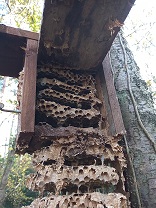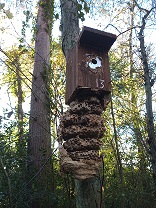Nature Notes November 2021
Date Published: 02-12-2021
The weather was mostly mild early on followed by several frosty nights at the month end. Storm Arwen hit on the last weekend with high winds damaging trees and overhead power lines.
SIGHTINGS
Birds (seen or heard) : Common Gulls, Black-headed Gulls, Herons, Carrion Crows, Sparrowhawk, Magpies, Jays, Buzzards, Tawny Owl, Wood Pigeons, Stock Doves, Green/great Spotted Woodpeckers, Nuthatches, Redwings, Blackbirds, Robins, Song Thrush, Dunnocks, Goldfinches, Greenfinches, Chaffinches, Siskins, Stonechats, Wrens, Coal/Blue/Great/Long-tailed Tits.
Insects: Bees, Midges.
Mammals: Roe Deer, Grey Squirrels, Foxes.
Butterflies: Large White, Peacock.
Plants (in flower/berry) : Holly berries, Rowan berries, Ivy seed heads, Sundews, Cotoneaster berries, Large White water Lily in flower.
Fungi: Sulphur Tuft, Snowy Inkcap, Scaly Rustgill, Fragrant Funnel, King Bolete, Bovine Bolete, Fly Ageric, Cowpat Gem, Conifer Tuft, Brown, Rollrim, Common Rust Gill, Variable Oysterling, Douglas Fir Cone Mushroom, Spotted Toughshank, Clouded Funnel, Turkey Tail, Brick Cap, Common Ballaria, Bay Bolete.
Pond Life: Whirlygig Beetles, Pond Skaters.
A Tawny Owl was seen during daylight, when disturbed from a low roosting place.
The start of Winter was marked by the return of Redwings on site, feeding on the Rowan and Holly berries. Severe weather conditions to the North of the country drove them south, but they will move on when the food source is depleted as they are nomadic.
The bird box clean out was started on the last weekend of the month, completing half of the boxes. An interesting find in one box was that of a wasps nest – a wonderful construction.
NATURE FACT
Most wasp colonies only survive a season with the nest only being used once. The queen survives to establish a future colony, but the rest of the colony dies. The cells are constructed by using thin scrapings of wood which the wasps mix with saliva in her mouth. This breaks down the fibres into a pulp which are then used for constructing hexagonal shaped cells in which the young are reared. This hexagonal structure technique is used by honey bees too.
Recorders: C Wilcox, K Wilcox
SITE MANAGEMENT
The monthly work party thinned out gorse along the southern fence line of the grazing enclosure and cleared invasive vegetation from the drainage ditch along the southern perimeter of the Reserve.






